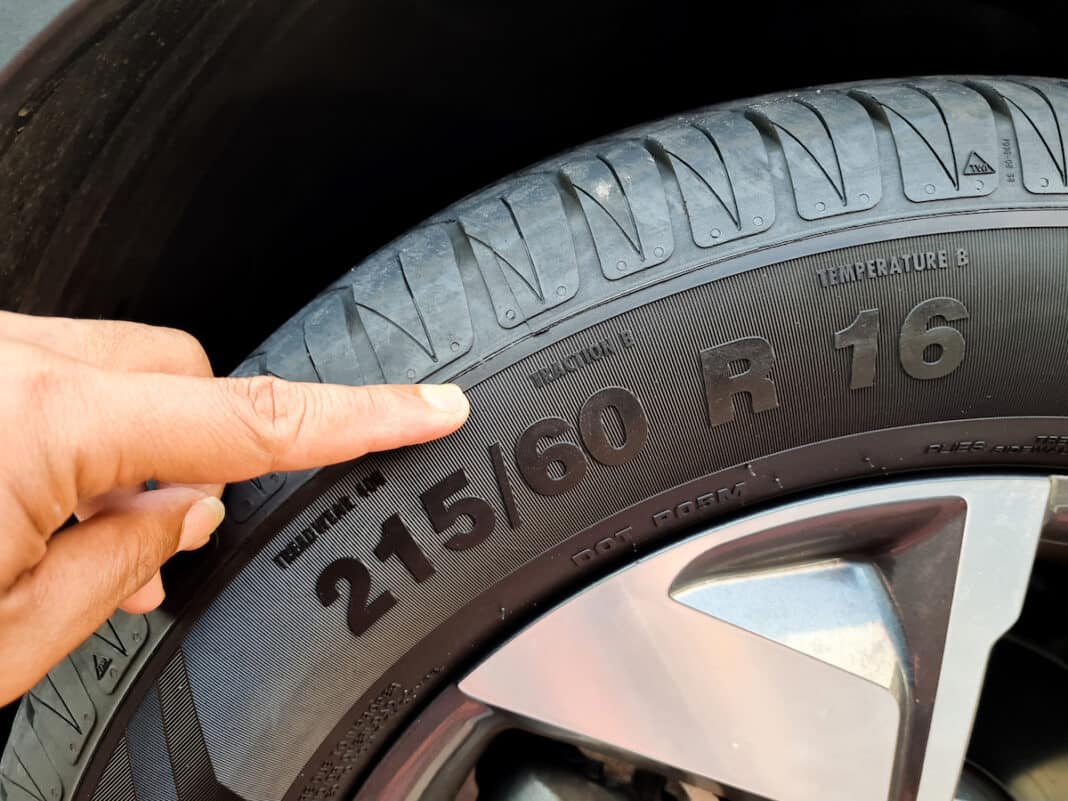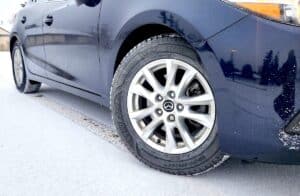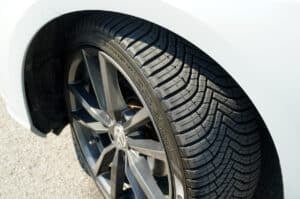This article was updated in 2024.
Those markings on the sidewalls of tires might seem like the kinds of scratches only a calculus major could understand, but they’re really not that complicated. Here’s a look at the various markings and what they mean.
In this article, we discuss:
- What tire sizes mean and how to read them
- The tire load index
- Speed ratings explained
1. What do tire sidewall markings mean, and how do you read them?
Here’s a standard tire size: P215/60R16 – as shown below:
- 1. Metric, or tire type
- 2. Tire width
- 3. Rim diameter
- 4. Speed rating
- 5. Aspect ratio
- 6. Construction
- 7. Load index

- The first letter, P, means it’s a passenger car tire. Tires for a pickup or some sport-utility vehicles might start or end in LT, meaning light truck.
- The 215 is the tire’s width in millimeters from sidewall to sidewall.
- The 60 refers to the ratio between the width and height of the sidewall. In this case, the sidewall is 60 percent of the width, 60 percent of 215.
- The R means radial, as in the construction style, while the 16 means it rides on wheels with 16-inch diameters.
When the tires were built: here’s how to know

You might also want to know how current your tire is; there’s a code for that, too. Look for four numbers grouped. For example, 0918 in this picture means the tire was built on the 9th week of 2018.
Reading a tire size correctly is essential, and here’s why
These numbers are necessary to get right when looking for tires, as a P225/55R17 tire will have a different overall diameter and throw off your speedometer. Also, tires with lower aspect ratios will ride rougher and increase the risk of wheel damage, as there is less sidewall to absorb bumps.
As an example of a performance tire size, the Porsche 911 Turbo S Coupe takes 305/30R20 on the rear, or 305 mm wide, 30 percent aspect ratio (sidewalls are only 91.5 mm high), on 20-inch wheels.
Sidewall Markings: 3 Popular Types
Tire sidewalls don’t all look the same. For example, Goodyear Tires offers three types of sidewall styles for their products:
- Black: all-black sidewall with black lettering
- Whitewall: white bands on the sidewall vary in width
- Letters Outlined: letters on the sidewall are outlined in white

2. What is the tire load index?
This number can range from 75 to 120, and each number in between corresponds to the maximum load a tire can support when properly inflated.
For example, the tires with a rating of P225/65R17 have a tire load index of 100, which translates to 1,764 pounds (on these tires, it was rounded down to 800 kilograms), which, when multiplied by four tires, leaves plenty of headroom for cargo and people. (The curb weight is 1,659 kilograms.)
Each increase by one in the tire load rating (from 100 to 101, for instance) increases the load capacity by 55 pounds (almost 25 kilograms).
Tire Load Index Chart
Please note that a speed rating symbol typically follows the load index, and both are marked on the tire’s sidewall to indicate its load and speed capabilities. Always ensure that the load index of your tires meets or exceeds the requirements for your vehicle and intended use.
Tire Load Index Chart [click to expand table]
| Load Index | Maximum Load Capacity (lbs) | Maximum Load Capacity (kg) |
|---|---|---|
| 71 | 761 | 345 |
| 72 | 783 | 355 |
| 73 | 805 | 365 |
| 74 | 827 | 375 |
| 75 | 853 | 387 |
| 76 | 882 | 400 |
| 77 | 908 | 412 |
| 78 | 937 | 425 |
| 79 | 963 | 437 |
| 80 | 992 | 450 |
| 81 | 1019 | 462 |
| 82 | 1047 | 475 |
| 83 | 1074 | 487 |
| 84 | 1102 | 500 |
| 85 | 1135 | 515 |
| 86 | 1168 | 530 |
| 87 | 1201 | 545 |
| 88 | 1235 | 560 |
| 89 | 1279 | 580 |
| 90 | 1323 | 600 |
| 91 | 1356 | 615 |
| 92 | 1389 | 630 |
| 93 | 1433 | 650 |
| 94 | 1477 | 670 |
| 95 | 1521 | 690 |
| 96 | 1565 | 710 |
| 97 | 1609 | 730 |
| 98 | 1653 | 750 |
| 99 | 1709 | 775 |
| 100 | 1764 | 800 |
| 101 | 1819 | 825 |
| 102 | 1874 | 850 |
| 103 | 1929 | 875 |
| 104 | 1984 | 900 |
| 105 | 2039 | 925 |
| 106 | 2094 | 950 |
| 107 | 2149 | 975 |
| 108 | 2205 | 1000 |
| 109 | 2271 | 1030 |
| 110 | 2337 | 1060 |
| 111 | 2403 | 1090 |
| 112 | 2469 | 1120 |
| 113 | 2535 | 1150 |
| 114 | 2601 | 1180 |
| 115 | 2679 | 1215 |
| 116 | 2756 | 1250 |
| 117 | 2833 | 1285 |
| 118 | 2910 | 1320 |
| 119 | 2998 | 1360 |
| 120 | 3086 | 1400 |
3. Speed Tire Rating Explained
Tires are under extreme amounts of force, not only in holding up the vehicle above but at speed. There are also excessive amounts of centripetal and centrifugal force acting on the tires. The centripetal force refers to the forces acting in line with the arc of rotation of the tire, while centrifugal force refers to the forces pushing away from the centre of the tire.
Both forces are central to a tire’s speed rating: too weak a tire could tear itself apart at too great a speed. The tire speed rating is a letter, ranging — non-linearly — from Q to ZR. Q-rated tires specify a maximum of 99 miles per hour.
Fortunately, we don’t see too many of those in passenger-car applications. More likely is H, or 130 miles per hour. V rating means 149 miles per hour, while Y equals 186 miles per hour.
What you do need to know, however, is that you shouldn’t mess around with speed ratings. If your car has a V-rated tire, don’t replace it with an H-rated tire.
Above 186, it gets a bit more complex, with ZR usually applied to such tires, but the ZR has to be accompanied by the Y. These tires typically have ratings above 186 miles per hour (300 km/h).
The other factor that speaks to speed rating is the tire’s tread, which can bring the car to a halt at such high speeds. Since these higher speeds are typically only seen on racetracks, even on Germany’s Autobahn, they’re beyond the scope of our discussion here.
What you do need to know, however, is that you shouldn’t mess around with speed ratings. If your car has a V-rated tire, don’t replace it with an H-rated tire.
Tire Speed Rating Chart
Note: it’s essential to choose tires with a speed rating that matches or exceeds your vehicle’s top speed capabilities and driving conditions.
Tire Speed Rating Chart [click to expand table]
| Speed Rating | Maximum Speed (km/h) | Maximum Speed (mph) |
|---|---|---|
| L | 120 | 75 |
| M | 130 | 81 |
| N | 140 | 87 |
| P | 150 | 93 |
| Q | 160 | 99 |
| R | 170 | 106 |
| S | 180 | 112 |
| T | 190 | 118 |
| U | 200 | 124 |
| H | 210 | 130 |
| V | 240 | 149 |
| W | 270 | 168 |
| Y | 300 | 186 |
| (Y) | Over 300 | Over 186 |
There you have it, an in-depth look at that letter and digits on passenger vehicle tire sidewalls and what they all mean. At first glance, it’s all quite overwhelming. But once you break it down into each part – from tire size and load index to speed rating and symbols – it begins to make sense.






